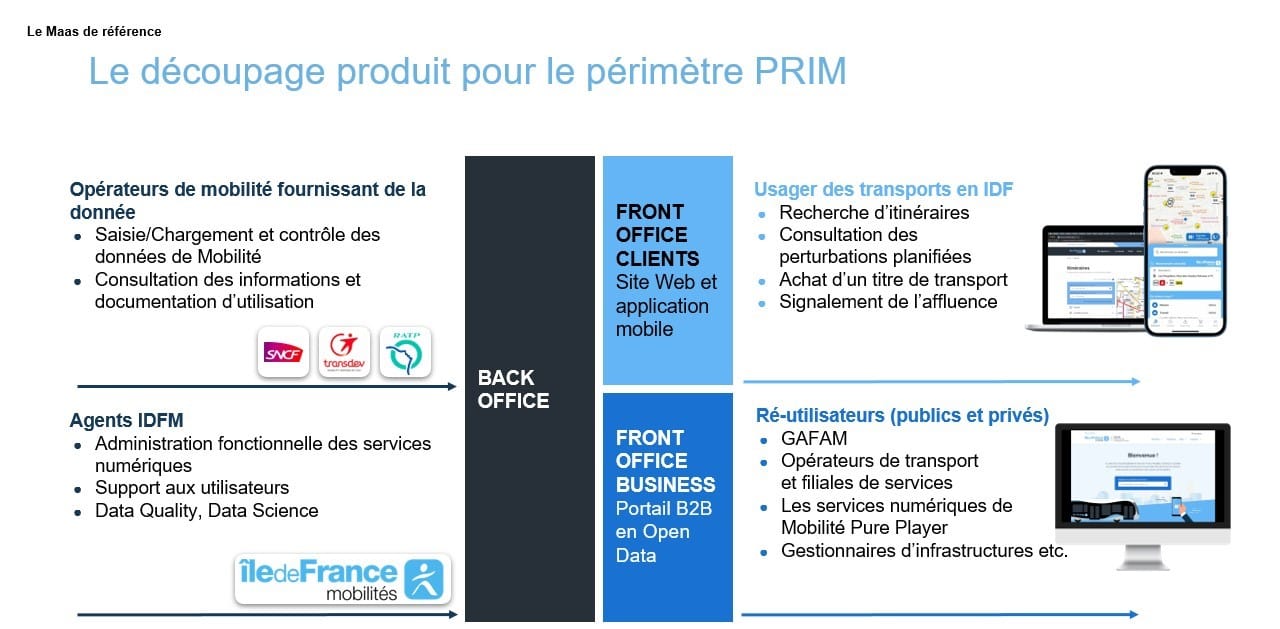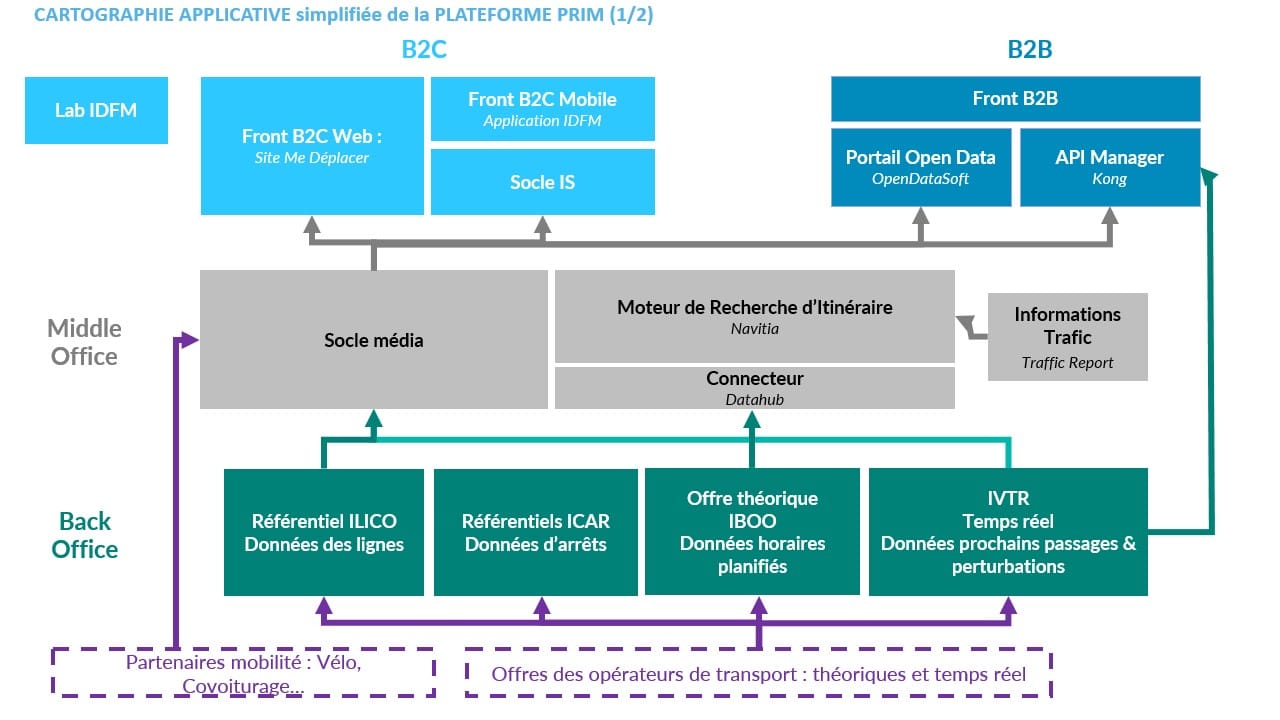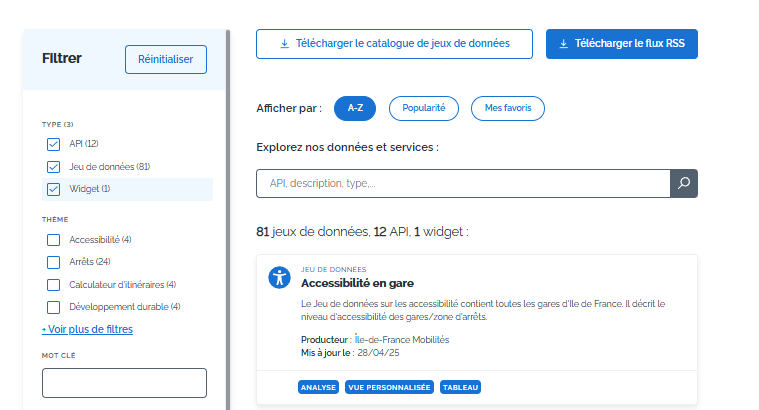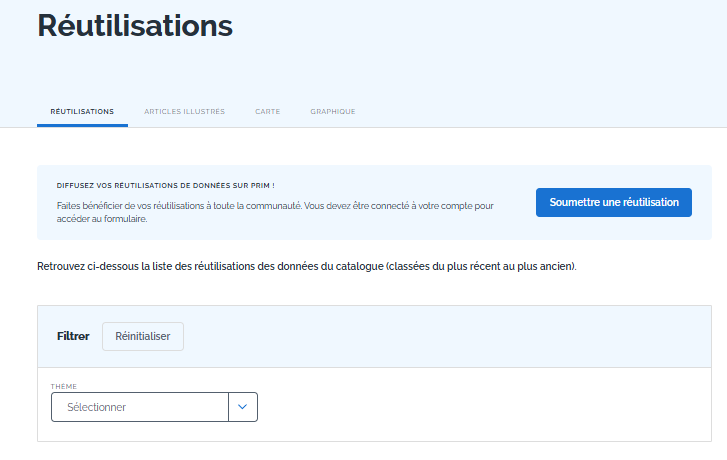33,000 stops, more than 1500 bus lines, 13 tram lines, 16 metro lines, 13 RER/Transilien lines, 20,000 Véligo bicycles : the Île-de-France transport network is the2nd densest in the world – after London. It is operated by more than 70 companies such as SNCF, RATP, Transdev, Keolis. 9.1 million trips are made daily by public transport.
In this context of abundant mobility offers, the Regional Mobility Information Portal (PRIM) represents a crucial resource for centralizing all this data on mobility in Île-de-France, whether static (dataset) or dynamic (APIs).
Here we propose to examine the structure of PRIM by highlighting the different data sources and their use within the system.
I. What data sources does PRIM use?
The data on transport in Île-de-France on PRIM come from many very heterogeneous sources. They are all brought together on a single portal to facilitate their use and to offer complete and reliable information.

1. Carrier operators
The major providers of public transport data are the operators operating transport lines in Île-de-France such as: SNCF, RATP, Transdev, Keolis, LACROIXSAVAC, RATPCAP. They are at the heart of collecting this critical data. This information includes scheduled schedules, stops, lines, and connections. They are fundamental to supplying all the services and media of Île-de-France Mobilités. In addition, carriers provide real-time data, such as upcoming transits, network status, disruptions and incidents, thus keeping information up-to-date for users.
2. Partners
In addition to carriers, many mobility players (Vélib for example) also play a crucial role in enriching the available data. They provide additional information such as that relating to self-service bicycle or carpooling services, thus helping to diversify and complete the mobility offer in Île-de-France.
3. Internal sources
Île-de-France Mobilités' internal teams, for their part, constantly monitor the integrity and updating of these various databases.

II - Data processing
Once collected, the data is carefully processed and enriched to ensure reliability.
This processing goes through several key steps that make it possible to structure and harmonize the information.
Benchmarks
Repositories are structured databases that contain standardized information about stations, stops, lines, and geographic areas. They ensure the consistency and quality of data in PRIM, ensuring harmonized information management across all data sources. The work is carried out in specific collaborative tools developed by Île-de-France Mobilités (ICAR and ILICO) and used by both carriers and internal teams.
Theoretical supply management
The theoretical offer Includes all the forecast information on the transport lines, schedules, frequencies and routes of the different modes of transport. Île-de-France Mobilités uses its version of the CHOUETTE software (IBOO) to collect this information from carriers, and to generate this offer for the next 30 days. Every day, this information is updated and integrated directly into Navitia, the route calculation tool.
Integration with Navitia
The integration of the repositories and the theoretical offer in Navitia is done in the NETEX format. This makes it possible to efficiently feed the search for routes through the different media (mobile application, website, etc.) used by users and mobility services. The GTFS made available on PRIM is produced from data extracted from Navitia.
Traffic information
Traffic information is the messages relating to the state of traffic in real time, by line or by mode of transport. Île-de-France Mobilités uses its version of the Trafic Report software to manage this information with carriers. This information is then integrated into Navitia and disseminated on Île-de-France Mobilités' media (mobile application, web portal and PRIM platform).
The next passes in real time
The IVTR Relay, in place since 2015, centralises the next visits in real time. It orchestrates the exchange of data between carriers, collects information and disseminates it in different SIRI formats. Once processed by the IVTR Relay, this data is broadcast live on the Île-de-France Mobilités media. Work is underway to standardize these exchanges (SIRI) and integrate them into the IVTR relay.
III. Dissemination of data
The data collected and processed by PRIM is then disseminated in various ways, depending on the needs of users and mobility professionals. Dissemination via Île-de-France Mobilités (B2C) media is the most obvious: once the data has been processed, it is made available to users through these IDFM media (website, mobile application, etc.).
However, thanks to PRIM, the dissemination of this data is not limited to the audience of the Île-de-France Mobilités media. Thanks to Open Data, a "B2B" distribution is also made. This allows data reusers, such as companies or developers, to access the most recent information to reintegrate it into their own services, thus contributing to consistency in information related to mobility in Île-de-France but also to innovation in the sector.
To find this data and many others, go to PRIM! A recent redesign of the filter system in the Data Catalog now makes it easier for reusers to find data relevant to their use case.

For any questions, we remain available on the Slack of the "PRIM community" as well as at the email address: [email protected] to answer your questions and welcome your suggestions.
If you reuse data from PRIM, we invite you to declare your reuses and organizations !
